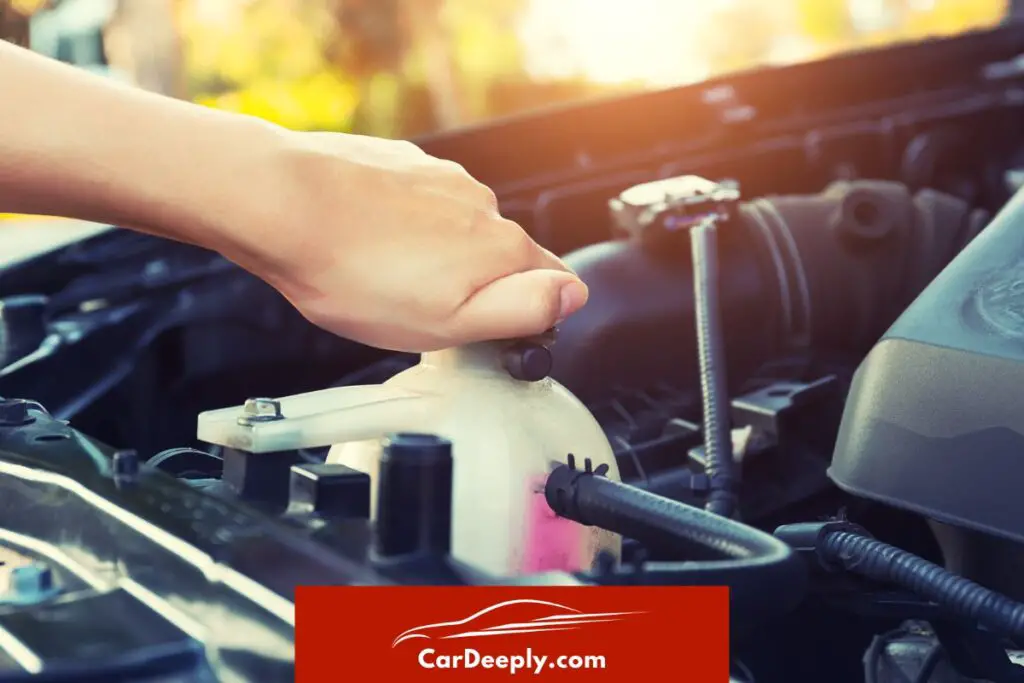Discovering your coolant reservoir empty can be a heart-stopping moment for any car enthusiast. This article is your ultimate guide to understanding why this happens and how to fix it, saving you from costly mistakes and unnecessary stress.
By reading on, you’ll gain the following:
- Detailed insights into the reasons behind an empty coolant reservoir.
- Practical, easy-to-follow steps to fix the issue.
- Expert tips to prevent future coolant problems.
Don’t let an empty coolant reservoir leave you stranded. Dive in now to equip yourself with the knowledge you need to keep your vehicle running smoothly.
Let’s go!
Advertising links are marked with *. We receive a small commission on sales, nothing changes for you.
Key Takeaways

- The coolant reservoir stores coolant, preventing engine overheating.
- Coolant leaks, often due to system faults, can empty the reservoir.
- A faulty radiator cap can cause coolant overflow and leakage.
- A malfunctioning water pump can lead to low coolant levels.
- A blown head gasket can cause coolant to leak into the engine.
What is a Coolant Reservoir?
The coolant reservoir, also known as the coolant expansion tank, is vital to your car’s cooling system. It’s where the coolant – a mixture of water and antifreeze – is stored.
This liquid plays a crucial role in keeping your engine from overheating.
When your engine is running, it generates heat. The coolant absorbs this heat and carries it away, maintaining the engine at an optimal temperature. As the coolant heats up, it expands.
The coolant reservoir provides extra space for this expansion, preventing pressure build-up in the cooling system.
Why is Coolant Important for Your Car? (200 words)
Coolant is the unsung hero of your car’s performance. It’s more than just a heat absorber; it’s a lifeline for your engine. Here’s why:
- Prevents Overheating: Coolant absorbs and dissipates heat from the engine.
- Prevents Freezing: In cold weather, coolant prevents the water in your engine from freezing.
- Lubricates: Coolant lubricates the water pump, extending its life.
- Prevents Corrosion: The antifreeze in coolant helps prevent rust and corrosion in the cooling system.
Without coolant, your engine could overheat, leading to severe damage and potentially costly repairs.
Signs That Your Coolant Reservoir is Empty
An empty coolant reservoir is a red flag that shouldn’t be ignored. Here are some telltale signs:
Engine Overheating
If your engine runs hotter than usual, it could be due to a lack of coolant. An overheating engine can cause serious damage, so addressing this issue promptly is essential.
Coolant Light On
Most cars have a warning light on the dashboard that illuminates when the coolant level is low. If this light comes on, it’s time to check your coolant reservoir.
Visible Coolant Leak
If you notice a bright green, orange, or pink fluid under your car, it’s likely a coolant leak. This could be due to a leak in the reservoir or elsewhere in the cooling system.
White Smoke from the Exhaust
White smoke from the exhaust can indicate a coolant leak. If coolant is leaking into the engine, it can be burned off, resulting in white smoke.
If you notice any of these signs, you must check your coolant reservoir and refill it if necessary. However, more than simply filling the reservoir may be needed to solve the underlying problem.
The next section explores why your coolant reservoir might be empty and how to fix it…
Reason 1: Leaks in the System
One of the most common reasons for an empty coolant reservoir is a leak in the system. Leaks can occur in various places, including the radiator, hoses, water pump, or reservoir.
How to Identify Leaks
Spotting a coolant leak can be complicated. Here are some clues:
- Puddles: Look for bright-colored liquid under your car.
- Low Coolant Level: There might be a leak if you’re constantly topping up your coolant.
- Coolant Odor: A sweet, syrup-like smell could indicate a coolant leak.
How to Fix Leaks
Fixing a coolant leak depends on where it’s coming from. A radiator stop leak product might do the trick for minor leaks in the radiator or hoses.
You’ll likely need to replace the faulty part for more significant leaks or if the water pump is the culprit. If you’re uncomfortable doing this, it’s best to take your car to a professional mechanic.
Reason 2: Faulty Radiator Cap
A faulty radiator cap can cause your coolant reservoir to empty. The cap maintains the correct pressure in the cooling system. Coolant can be pushed into the reservoir if it’s not working properly and then leak out.
Identifying a Faulty Radiator Cap
A faulty radiator cap often results in the following:
- Overheating Engine: The cap can’t maintain the right pressure, leading to overheating.
- Coolant Leaks: Coolant may escape from the overflow tube.
Replacing a Radiator Cap
Replacing a radiator cap is a simple and inexpensive fix. Ensure the engine is cool before removing the old cap to avoid burns from the hot coolant. Then, replace it with a new one that fits your car’s specifications.
Reason 3: Faulty Water Pump
The water pump circulates coolant through the engine. If it’s faulty, it can lead to a low coolant level.
Identifying a Faulty Water Pump
Signs of a faulty water pump include:
- Coolant Leak: Look for leaks near the front of your car.
- Overheating Engine: A failing pump can’t circulate coolant properly.
Replacing a Water Pump
Replacing a water pump is a more complex task. If you need to become more experienced in car repair, it’s best to leave this to a professional.
Reason 4: Blown Head Gasket
A blown head gasket can cause coolant to leak into the engine, where it’s burned off and exits through the exhaust.
Identifying a Blown Head Gasket
Signs of a blown head gasket include:
- White Smoke: Look for white smoke from the exhaust.
- Milky Oil: Coolant in the oil can give it a milky appearance.
Fixing a Blown Head Gasket
Fixing a blown head gasket is a significant repair that a professional should do. It’s crucial to address this issue promptly to prevent further engine damage.
Frequently Asked Questions
Can I drive my car with an empty coolant reservoir?
It’s not advisable to drive your car with an empty coolant reservoir. Doing so can lead to overheating and severe engine damage. If you notice your coolant reservoir is empty, refill it immediately and investigate the cause.
How often should I check my coolant level?
It’s a good practice to check your coolant level every time you fill up your gas tank. Also, make it a habit to inspect the coolant during routine car
What type of coolant should I use for my car?
The type of coolant you should use depends on your car’s make and model. Always refer to your vehicle’s owner’s manual for the recommended type of coolant.
Can I mix different types of coolant?
Mixing different types of coolant is not recommended. Other coolants have different chemical compositions that may not be compatible and can lead to engine damage.
What should I do if I can’t find the source of the coolant leak?
If you cannot find the source of the coolant leak, it’s best to take your car to a professional mechanic. They have the tools and expertise to diagnose and fix the problem.

Sebastian loves convertibles and drove a BMW 335i for a long time (325 hp is just a dream). Today, with two children, he is more concerned with SUVs and family-friendly vehicles. In addition to an Audi A4 Avant, he also drives a Cupra Formentor VZ – even as a family man, you can’t do without speed. Get to know Sebastian better and visit the About Us page.
Advertising links are marked with *. We receive a small commission on sales, nothing changes for you.
